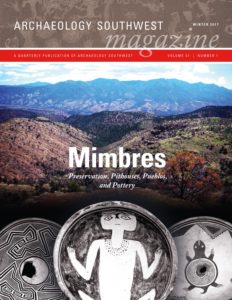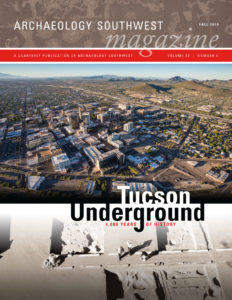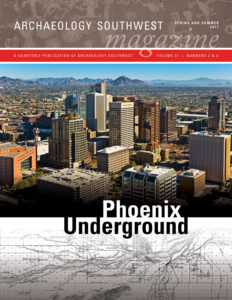Explore additional content related to Should We Stay or Should We Go? Farming and Climate Change, 1000–1450 CE, the March 2, 2021 Archaeology Café Online presentation with Karen Schollmeyer and Scott Ingram.
Extended Q&A with Karen Schollmeyer
Q: In the Mimbres area, what were the population levels of the (wetter) Mimbres Valley and (drier) Eastern Mimbres area before AD 1130?
A: The Mimbres Valley had a much larger population than the Eastern Mimbres area before 1130. The broad floodplain of the perennial Mimbres River meant farming there could support many more people than the mostly ephemeral streams and smaller floodplains of the Eastern Mimbres area, and population estimates based on room counts show that the Mimbres Valley’s population was more than double that of the Eastern Mimbres area.
From 1130 through the early 1200s, only a few of the once-large villages along the central and southern portion of the Mimbres River retained small populations. Population levels there declined by about 99%. In the eastern Mimbres area, the overall population declined by about 70%, but we don’t see any evidence that people stayed in the old Classic Mimbres villages. Instead, they moved into small scattered hamlets, many built on the sites of old Classic Mimbres fieldhouses. You can read more about the evidence for this in the book Mimbres During the Twelfth Century: Abandonment, Continuity, and Reorganization by Margaret C. Nelson (University of Arizona Press, 1999).
Most archaeologists working in the area see this as too large and rapid a population change to be the result of a lower birthrate during a drought, and so we think that many people moved out of the area and into other regions. It’s been hard for us to see where they went, because they stopped making the distinctive pottery archaeologists recognize them by, but there is some evidence they are ancestral to Puebloan people today (in places like Zuni and Acoma) and that some moved south to the area around what would later become Paquimé.
Q: What are some of the other factors that might have influenced migration in the Mimbres area? Is there evidence of conflict, disease, loss of wild resources, or the influence of social ties to other places?
A: Most archaeologists today favor multicausal explanations for the end of Mimbres—we think drought and other economic and social factors all contributed to people’s decisions to change their material culture and (often) to move. In the Mimbres Valley, bioarchaeological studies from older excavation projects have not shown evidence of much conflict, disease, or significant nutrient deficiencies. In the Mimbres Valley, archaeologist Paul Minnis and others have argued that there was not enough well-irrigated farmland after 1120 to support the population there (which is a different situation from the Eastern Mimbres, as I discuss in this talk), although more people could have been supported there than the number who remained after 1130. Evidence from ancient wood found in buildings and hearths, burned seed remains in hearths, and local small animal populations shows that in both areas, there were fewer floodplain trees around villages and more weedy plant species during the Classic Mimbres period than centuries earlier when populations were lower. Again, this wouldn’t force people to leave, but it probably contributed. Studies of animal bones show that deer and pronghorn were rare around Classic Mimbres villages, too, but probably had been for centuries. All of these factors together would have contributed to people’s decision to stop making distinctively Mimbres items to show this identity, and in many cases to move. Instead of a single cause, many of us working on these questions now think that all of these changes together led people to perceive that their way of doing things was no longer working. They responded by letting go of the “Mimbres identity” we see in the archaeological record and taking on new identities, either in new homes in the same area (as in the Eastern Mimbres area) or in more distant places to which they moved.
Social ties to other places would have made moving much easier, especially if people had connections to places where things seemed more appealing. During the Classic Mimbres period, people didn’t show these social connections with imported decorated pottery—a big difference from other times and places in the Southwest, when showing these connections with pottery was very important. After 1130, however, the people who stayed in the Eastern Mimbres area used a very diverse set of decorated pottery in styles from areas all around them, clearly signaling that these connections were important to them.
Extended Content:
Read Archaeology Southwest Magazine (Vol. 31, No. 1), “Mimbres Preservation, Pithouses, Pueblos, and Pottery,” available as a free PDF download for members* of Archaeology Southwest, here.

Read Archaeology Southwest Magazine (Vol. 32, No. 4), “Tucson Underground,” available as a free PDF download for members* of Archaeology Southwest, here.

Read Archaeology Southwest Magazine (Vol. 31, Nos. 2 & 3), “Phoenix Underground,” available as a free PDF download for members* of Archaeology Southwest, here.

See also:
- The Archaeology and Meaning of Mimbres. Vol. 17, No. 4 (Fall 2003)
- Blog: Life of the Gila: Was Mimbres a World?
- Blog: Life of the Gila: The Hohokam Worlds
Further reading:
Human Vulnerability to Climatic Dry Periods in the Prehistoric U.S. Southwest. Scott Ingram. Doctoral Dissertation. Arizona State University (ASU), School of Human Evolution and Social Change. 2010 ( tDAR id: 457658) ; doi:10.6067/XCV8457658
Schollmeyer, Karen Gust. 2011. Large Game, Agricultural Land, and Settlement Pattern Change in the Eastern Mimbres Area, Southwest New Mexico. Journal of Anthropological Archaeology 30:402-415.
More from Karen Schollmeyer:
* Issues of Archaeology Southwest Magazine published within the past five years are available as free PDF downloads for members of Archaeology Southwest. Need help accessing your download? Let us know. Not yet a member? Join today.
To stay informed about future online presentations and video releases, join our email list below:
Sign up for emails